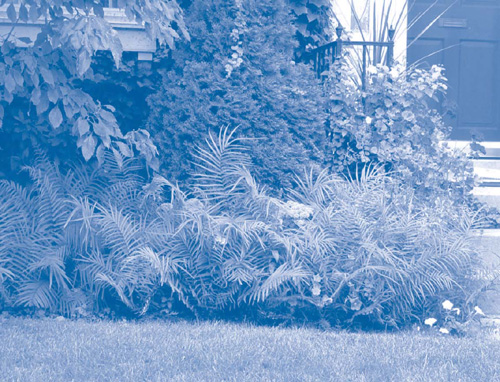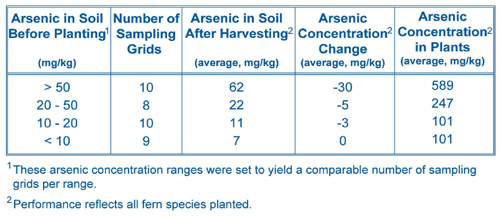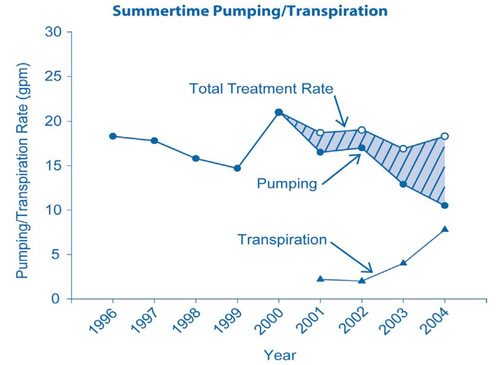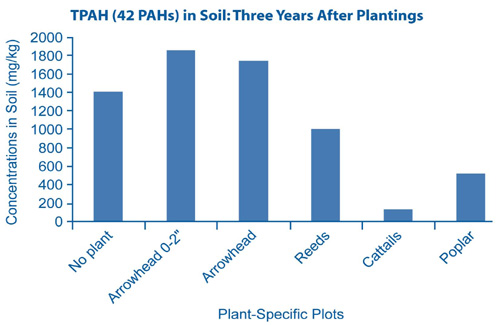This issue of Technology News and Trends highlights field applications of phytoremediation to remove, transfer, stabilize, or destroy contaminants in soil, sediment, or ground water. Each application employs one or more of the primary mechanisms used by plants to remediate sites: phytoextraction, enhanced rhizosphere biodegradation, hydraulic control, phytodegradation, and phytovolatilization.
Compacted Clay and ET Landfill Covers Compared in Humid Climate
CLU-IN Resources
Phytoremediation is one of 19 focus areas addressed in CLU-IN’s Technology Focus, an online compilation of information on remediation technologies. Visit http://www.cluin.org/techfocus to learn more about the basics of phytoremediation, view site-specific application summaries, consider upcoming training opportunities, and access additional online resources. Technology Focus also allows users to review and download new guidance materials, such as the Remediation Technologies Development Forum’s 2005 Evaluation of Phytoremediation for Management of Chlorinated Solvents in Soil and Groundwater.
The U.S. EPA National Risk Management Research Laboratory (NRMRL) Alternative Cover Assessment Program (ACAP) collaborated with the Desert Research Institute (DRI) and University of Wisconsin-Madison to evaluate the field performance of two RCRA “final” cover designs proposed for use on a Superfund landfill in Albany, GA. The evaluation was conducted at the Marine Corps Logistics Base (MCLB), where facility-wide remediation requires installation of multiple landfill covers for wastes generated by past military activities.
The EPA, U.S. Navy, and U.S. Marine Corps partnered in construction and operation of field pilot-test cells at the MCLB to use in identifying alternative covers that meet standard performance criteria while offering potential cost savings. Two 20- by 30-meter test cells were constructed immediately adjacent to an existing landfill, each containing a 10- by 20-meter lysimeter to monitor water balance during the evaluation. Each lysimeter was constructed of a low-density polyethylene liner protected by a geocomposite drainage layer.
An evapotranspiration cover (ETC) was proposed as an alternative design to a compacted-clay conventional cover. ETC systems use vegetation and one or more soil layers to retain water until it is either transpired through vegetation or evaporated from the soil surface. The technology is based on site water-balance components such as soil water-storage capacity, precipitation, surface runoff, evapotranspiration, and infiltration. Due to the Albany region’s high average monthly rainfall (2 to 6 inches) and high precipitation-to-potential evapotranspiration ratio (1.10), the efficacy of an ETC system in such a climate was unclear prior to the pilot test.
In the ETC test cell, 2.3 feet of native sandy soil were placed on a synthetic root barrier overlaying a 6-inch layer of “interim” cover soil. Though not typically employed in final-cover designs, the barrier and interim-cover soil (Figure 1) helped to ensure proper functioning of the test lysimeters. An additional 2 feet of native sandy-clay soil, amended with peanut-shell-composted biosolids from a local wastewater treatment plant, were placed on the non-amended soil. Finally, two-year-old poplar trees were planted at 30-inch depths with an understory of grasses. This approach achieved an ETC with a thickness of 4.3 feet.

The cover for the second test cell was constructed of 18 inches of compacted clay using conventional techniques for RCRA Subtitle D landfill covers. As in the ETC test cell, the material was placed on a synthetic root barrier to separate the cover from 6 inches of underlying interim-cover soil. The clay then was topped by a surface layer comprising 6 inches of topsoil seeded with native (Bermuda and rye) grasses, resulting in a conventional cover thickness of 2 feet.
A weather station was installed adjacent to the lysimeters to measure precipitation, temperature, relative humidity, solar radiation, and wind speed and direction. All data were collected hourly and transmitted daily to DRI for analysis.
Monthly monitoring of the water balance over three years indicated that the alternative ETC system performed better than the conventional compacted-clay barrier. Four years after construction, hydraulic conductivity measurements on the compacted-clay barrier were conducted in the field with a sealed double-ring infiltrometer and two-state borehole permeameters. In addition, laboratory measurements were conducted on hand-carved blocks collected during construction and after four years of service. Test results indicated that hydraulic conductivity increased approximately three orders of magnitude (<10-7 to
>10-4cm/s) in four years.
A dye-tracer test and soil-structure analysis confirmed that extensive cracking and root development occurred throughout the entire depth of the compacted-clay layer of the conventional cover. Patterns in the response of drainage to precipitation suggest that preferential flow paths developed in the compacted clay soon after construction, likely in response to irreversible cracking from soil desiccation.
Final results of the evaluation suggested that the site’s wet/dry cycles and root penetration caused the clay barrier to begin failing within the first eight months of service. These findings are similar to those of other ACAP laboratory and field studies showing that conventional clay barriers also degrade quickly in cool/humid or warm/dry environments and only minimally reduce percolation.
Feasibility study cost estimates for installing a full-scale, 17-acre ETC and monitoring over 30 years are approximately one-half ($10.5 million) of those associated with a conventional cover. Additional details on this field comparison and the results of other ACAP projects are available at http://www.acap.dri.edu.
Contributed by Steven Rock, NRMRL (rock.steven@epa.gov or 513-569-7149), Bill Albright, DRI (billa@dri.edu) and Craig Benson, University of Wisconsin-Madison (benson@engr.wisc.edu)
Ferns Successfully Extract Arsenic from Soil in Mid-Atlantic Climate
The U.S. Army Corps of Engineers (USACE) recently completed the second year of a field verification study on the potential for phytoremediation to address elevated arsenic concentrations in soil at the Spring Valley Formerly Used Definse Site (FUDS) in Washington, DC. The study began in 2004 at two residential areas and one public-access area and expanded in 2005 with nine additional residential areas. Five species of ferns were selected for their demonstrated capability to extract and store arsenic in their fronds. The use of small plants such as ferns also minimized destruction of existing neighborhood trees and other sensitive landscape features during the planting process.
Spring Valley FUDS encompasses approximately 661 acres used by the U.S. Department of Defense during World War I for production and testing of chemical warfare agents, some of which contained arsenic. Investigative soil sampling starting in 2001 indicated arsenic concentrations above the clean-up goal of 20 mg/kg at a total of 140 sites, primarily in the upper surface soil (< 12-inch depths). Although a 2003 engineering evaluation and cost analysis specified excavation and backfill as the primary clean-up remedy, efforts were initiated the following year to evaluate phytoremediation as an alternative for contaminant hotspots in sensitive areas. With typical root depths of 12 inches, ferns were deemed capable of preventing long-term exposure to the elevated arsenic concentrations.
Based on the results of a 2004 greenhouse feasibility study on soil collected from Spring Valley, the first year of the field study employed three species of ferns: Pteris vittata, P. cretica, and P. multifida. Approximately 2,800 plants were planted in May 2004 at 14 plots covering three property lots with arsenic concentrations of 16-127 mg/kg. The ferns were planted in an average density of 1/foot², and maintained through the summer by routine surface sprinkling. At the end of the growing season (November), ferns were harvested and biomass (plant matter above the roots) was collected for laboratory analysis. Plants were harvested by mowing at a height of one to two inches above the crown in order to preserve the plant root systems and enhance possibilities for regrowth the following season.
Plant analyses yielded arsenic concentrations of up to 1,500 mg/kg in plant biomass due to direct absorption by the roots. In addition, soil analyses indicated a reduction in soil arsenic concentrations to below the target level of 20 mg/kg in two of the 14 plots. The average decrease in soil arsenic concentrations across all plots was 9 mg/kg. Following laboratory use, the harvested biomass was disposed offsite as hazardous waste.
In 2005, field activities were expanded to include nine additional property lots, different site conditions, and additional fern species (P. mayii, P. nervosa, and P. parkerii). Approximately 10,000 ferns were introduced under existing trees and shrubs at 33 plots across 11 property lots (Figure 2). At 13 of the 14 plots studied in 2004, the planting areas were expanded to address elevated soil arsenic remaining at the edge of their former boundaries, and maintenance and data collection continued.

Results in 2005 showed that phyto-remediation was conducted with limited disruption to existing trees and perennial vegetation and was effective in decreasing soil arsenic concentrations (Table 1). Seventeen of the 33 test plots (sampling grids) planted in 2005 required no further action at the conclusion of the growing season.

Species performance comparison indicated that P. vittata produced the highest average biomass yields, averaging 35% greater than the other tested species and reaching an average dry-weight biomass of 2,743 kg/Ha. P. vittata’s higher biomass yields and tendency to accumulate higher concentrations of arsenic in fronds (up to 2,200 mg/kg in 2005) makes this species the most promising candidate for expanded phytoremediation at Spring Valley. In contrast, frond tissues of P. parkerii grown in soil with lower arsenic concentrations achieved arsenic concentrations that were only slightly higher than soil concentrations.
Analytical data from biomass and soil samples were used to determine each plant’s arsenic bioconcentration factor, which is the ratio of arsenic concentration in harvested plants to the concentration in soil. These factors provided an indirect measure of the extent to which plants were taking up and storing arsenic. For all test plots, the average plant bioconcentration factor was 12; bioconcentration factors greater than 10 are considered high.
Application of surface mulch at the end of the growing season enhanced the over-wintering of ferns, which could reduce project costs associated with subsequent replanting at plots requiring more than one year of treatment. To date, the estimated study cost is approximately $475,000, including $75,000 for greenhouse testing, $150,000 for 2004 field work and materials, and $250,000 for 2005 activities.
Based on these successful results, the USACE will continue the study in May 2006 to include additional properties and additional fern species. The USACE also plans to formally propose phytoremediation as an alternative to excavation and backfilling for arsenic remediation at Spring Valley properties where this approach would be more acceptable to property owners. As in previous years of the study, however, the presence of arsenic concentrations above 20 mg/kg at soil depths greater than 24 inches will preclude phytoremediation at a particular site.
Contributed by Ed Hughes, USACE (edward.t.hughes@nab02.usace.army.mil or 410-962-6784) and Michael Blaylock, Ph.D., Edenspace Systems Corporation (blaylock@edenspace.com or 703-961-8700)
Phytoremediation Reduces Mechanical Pumping and Ex-Situ Treatment of Ground Water
A ground-water phytoremediation system comprising a 0.8-acre stand of willows was installed in 1999 at the Solvents Recovery Service of New England (SRSNE) Superfund site in Southington, CT. The system is designed to pump and treat contaminated ground water, thereby seasonally reducing the extent of mechanical pumping and treatment. Thermal dissipation probes (TDPs) were used to estimate sap velocity for subsets of trees within the stand for several growing seasons. The total basal area of the stand was measured annually for use with mean sap-velocity data to estimate the rate of transpirational water use by the entire stand (VT). During the 2004 growing season, VT for the phytoremediation system appeared to reduce the volume of ground water needing ex-situ treatment by approximately 40%.
From 1955 to 1991, SRSNE reclaimed spent industrial solvents. Chemical releases resulted in contaminant source areas within former lagoons, drum and tank areas, and a processing area. The ground water contains volatile organic compounds (VOCs) existing as dense non-aqueous phase liquid in the overburden and bedrock and as light non-aqueous phase liquid in the overburden. The primary VOCs of concern in the ground water are trichloroethene, tetrachloroethene, 1,1-dichloroethane, trans-1,2-dichloroethene, cis-1,2-dichloroethene, 1,1,1-trichloroethane, ethylbenzene, toluene, and sec-butanol. Concentrations of individual VOCs of concern in the dissolved-phase plume range from 10 to 40 mg/L.
In 1995, a 700-foot-long, sheet-pile, barrier wall and 12 overburden ground-water recovery wells were installed as a non-time critical removal action (NTCRA) to control migration of the most highly contaminated ground water. Recovered ground water was routed at an average rate of 19 gallons per minute (gpm) to an ultraviolet-oxidation treatment facility that removed approximately 850 kg of VOCs per year, at an annual operation and maintenance cost of approximately $500,000 ($0.05/gal of water treated). Ground water within the 1.2-acre containment area is four to five feet below ground surface and meets the NTCRA compliance criterion requiring maintenance of an inward hydraulic gradient across the barrier wall.
An assessment of ground-water contaminant phytotoxicity was conducted in a greenhouse prior to planting trees onsite. A VOC mixture mimicking the dissolved-phase plume (170 mg VOCs/L) was tested using a system with hybrid poplar tree saplings (Populus deltoides x nigra) planted in 50-gallon barrels packed with alternating layers of pea gravel and sandy loam soil. The trees were watered using a system that automatically mixed neat (pure organic) VOCs with water and dispensed the cocktail into the bottom layer of gravel. Based on measured physiological parameters such as stomatal conductance, shoot elongation, and biomass production, no phytotoxic effects were observed.
Full-scale installation of the system at SRSNE began in late May 1998. Within the containment area, 10-12 four- to five-foot deep trenches were dug, deeply planted with approximately 1,000 bare-root hybrid poplar saplings, and backfilled with a sand/compost mixture. Only 60% of the saplings survived, likely due to the late planting and rapid onset of hot weather. The dead poplars were replaced the following spring with 400 (Salix alba) willow cuttings. Boreholes were drilled to the bottom of each backfilled trench, long hardwood willow cuttings were deeply planted, and the holes were backfilled with sand/compost. The willows thrived in a random distribution across the site and attained maturity (canopy closure) during the 2005 growing season, becoming a 370-tree stand spanning 0.8 acres. Due to a canker infestation (Cryptodiaporthe populea), however, all of the hybrid poplar trees were removed from the site in May 2002.
Ground-water pumping efficiency of the phytoremediation system is demonstrated by the calculated VT (Figure 3). The system’s treatment component likely includes various processes. Earlier studies show that the fate of chlorinated aliphatic compounds in ground-water phytoremediation systems involves plant uptake and release into the atmosphere (phytovolatilization), followed by photo-oxidation. A competing treatment process, particularly for BTEX compounds, is mineralization by bacteria residing in the rhizosphere around plant roots (rhizo-degradation).

During each growing season (May through September) from 2000 to 2003, five to seven trees were instrumented with TDPs. TDP data analysis employed the mathematical product of sap velocity (cm/h) and the cross sectional area of the stem (cm²) at the point of TDP insertion yielding sap flow (cm³/h). The measured mean sap velocity was 26.7 cm/h, and by 2003, the mean rate of sap flow for the instrumented trees was 72 L/d.
Measurement of each willow tree’s basal area was taken to determine the basal area for the entire stand, which increased from 1.4 m² in 2001 to 6.8 m² in 2004. These data were used with the mean TDP sap-velocity data to estimate VT. Between 2001 and 2004, the mean VT increased from 2.1 gpm to 8 gpm. Data suggested that VT at stand maturity, which was reached in 2005, was 9 gpm.
Chlorinated solvents, which are readily released into the atmosphere primarily from tree stems, were detected in xylem core samples obtained from multiple trees at the site. Based on the volume of ground water pumped by the trees in 2004 and on the VOC concentrations in ground water, it is estimated that approximately 340 kg of VOCs may have been removed in that growing season by processes such as phytovolatilization and rhizodegradation. Both the mechanical pump-and-treat system and the phytoremediation system will continue to operate indefinitely. The potential life-span of the planted willows is 80-100 years.
The total cost of the phytoremediation system is estimated at $281,900, including $15,500 for design, $40,400 for greenhouse studies, $115,300 for installation, $40,700 for replanting, and $70,000 for maintenance and monitoring. During the 2005 growing season alone, the achieved 1.9 million-gallon VT avoided equivalent use of the mechanical pump-and-treat system, resulting in a savings of $97,000. The "break even" point for project costs should occur in 2006, and a net cost savings of $470,000 is anticipated by 2010.
Contributed by Ari M. Ferro, ENSR (aferro@ensr.aecom.com or 919-872-6600), Karen Lumino, U.S. EPA Region 1 (lumino.karen@epa.gov or 617-918-1348), and Bruce Thompson, de maximis, inc.
Phytotechnology Expedites Removal of Oil Waste from Shoreline Sediment
The U.S. EPA NRMRL recently completed a three-year series of treatability studies on the use of phytotechnology to remediate sediment deposited on the shoreline of the Indiana Harbors Canal in Gary, IN. The canal shoreline comprises 15-35% oil, which greatly exceeds the 8% commonly considered to be the upper limit for effective bioremediation or phytoremediation. Trees, grasses, and tuberous plants were investigated for their ability to grow along the canal shoreline and degrade or contain the oil. The study also examined various planting techniques for addressing high contaminant concentrations in sandy soil.
The canal is located in an industrial area where past releases of oil refinery waste left hydrocarbons, most notably polyaromatic hydrocarbons (PAH), that constitute approximately 25% of the upper foot of riparian soil. The presence of recalcitrant hydrocarbons causes the soil to exhibit a heavily oiled appearance, texture, and odor in widespread areas devoid of vegetation. Occasional oil sheens threaten aquatic wildlife in the canal and reduce the quality of surface and ground water flowing into Lake Michigan.
NRMRL, Purdue University, North Carolina State, and Ohio State University collaborated in greenhouse and field studies to characterize the soil microbial population and plant viability within the study area. At NRMRL’s Cincinnati facility, initial experiments also were conducted in a growth chamber using contaminated soil from the canal. From the most viable cuttings, varieties of poplars and willows, sedges, and other native plants were planted along the canal in 2002. Additional cuttings were added in an adjacent plot the following year.
The study’s mixed planting approach worked to treat oil at multiple ground-water/surface water interfaces: the top foot of soil with grasses, the deeper soil and ground water with trees, and the water’s edge with tuberous plants. Plants introduced during the study were found to trap floating debris as canal waters rose and fell, catch windblown dust and seeds, catch vegetative litter, and provide anchorage for local opportunistic plants.
Plantings also established a root mass that formed a mat in the oily shore material. This biologically active layer helps control erosion, prevent sheen from entering surface water in the canal, and provide the habitat and nutrients needed for direct microbial degradation of the oil.
By 2004, there was a visual decrease in the sheen on the canal’s surface water. Many of the plants now growing at the study site are opportunistic volunteers such as common reeds (Phragmites australis), cattails (Typha latifolia), and arrowhead (Saittara latifolia). These non-planted species also have extensive roots systems that can penetrate the oily sand more vigorously than the planted trees. Though they generally do not offer high aesthetic value or wildlife habitat, these species possess high survival rates.
Disturbance of the site during planting activities, including breakage of an asphaltene layer and application of fertilizers, appeared to accelerate colonization of reeds and cattails significantly. Approximately 75% of the planted poplars and willows suffer from beaver damage. This damage, followed by water inundation caused by 1- to 2-foot canal level fluctuations and subsequent oily coating of young leaves, has resulted in difficulty employing tree species at this site.
Microbial activity in the soil increased 2-5 orders of magnitude by 2005. Analysis of soil samples collected within and outside the study area in 2003 and 2004 indicated that areas dominated by common reeds in both planted and unplanted areas contain the lowest concentrations of high-molecular-weight material. Areas dominated by cattails have the highest concentration of high-molecular-weight material and lowest concentration of low-molecular-weight material. Greenhouse tests on contaminated soil taken from the study area show more PAH degradation in planted plots than in unplanted plots (Figure 4). Though remediation of the canal is not complete or imminent, the use of phytotechnology is expected to accelerate natural degradation of the oil-based contaminants and ultimate ecorestoration of the canal.

Contributed by Ann Whelan, U.S. EPA Region 5 (whelan.ann@epa.gov or 312-886-7258) and Steven Rock, NRMRL (rock.steven@epa.gov or 513-569-7149)





